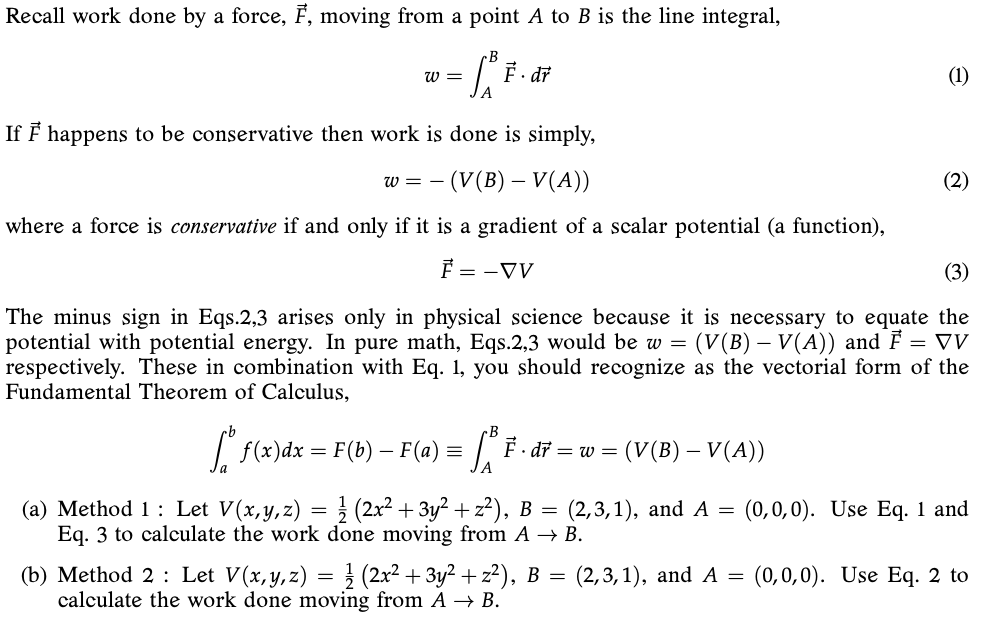Recall work done by a force, F, moving from a point A to B is the line integral, w = di (1) If F happens to be conservative then work is done is simply, - (V(B) – V(A)) (2) W = where a force is conservative if and only if it is a gradient of a scalar potential (a function), F = -V (3) The minus sign in Eqs.2,3 arises only in physical science because it is necessary to equate the potential with potential energy. In pure math, Eqs.2,3 would be w = (V(B) – V(A)) and F = VV respectively. These in combination with Eq. 1, you should recognize as the vectorial form of the Fundamental Theorem of Calculus, f(x)dx = F(b) – F (a) = F. dř = w = (V(B) – V(A)) (a) Method 1: Let V(x,y,z) = } (2x² + 3y² + z²), B = Eq. 3 to calculate the work done moving from A → B. (2,3,1), and A = (0,0,0). Use Eq. 1 and (b) Method 2 : Let V(x, y, z) = } (2x² + 3y² + z²), B = (2,3,1), and A = calculate the work done moving from A → B. (0,0,0). Use Eq. 2 to
Recall work done by a force, F, moving from a point A to B is the line integral, w = di (1) If F happens to be conservative then work is done is simply, - (V(B) – V(A)) (2) W = where a force is conservative if and only if it is a gradient of a scalar potential (a function), F = -V (3) The minus sign in Eqs.2,3 arises only in physical science because it is necessary to equate the potential with potential energy. In pure math, Eqs.2,3 would be w = (V(B) – V(A)) and F = VV respectively. These in combination with Eq. 1, you should recognize as the vectorial form of the Fundamental Theorem of Calculus, f(x)dx = F(b) – F (a) = F. dř = w = (V(B) – V(A)) (a) Method 1: Let V(x,y,z) = } (2x² + 3y² + z²), B = Eq. 3 to calculate the work done moving from A → B. (2,3,1), and A = (0,0,0). Use Eq. 1 and (b) Method 2 : Let V(x, y, z) = } (2x² + 3y² + z²), B = (2,3,1), and A = calculate the work done moving from A → B. (0,0,0). Use Eq. 2 to
Algebra & Trigonometry with Analytic Geometry
13th Edition
ISBN:9781133382119
Author:Swokowski
Publisher:Swokowski
Chapter8: Applications Of Trigonometry
Section8.3: Vectors
Problem 60E
Related questions
Question
I am struggling with this problem. I need help with a and b. Also, want to see detailed steps.

Transcribed Image Text:Recall work done by a force, F, moving from a point A to B is the line integral,
w =
di
(1)
If F happens to be conservative then work is done is simply,
- (V(B) – V(A))
(2)
W =
where a force is conservative if and only if it is a gradient of a scalar potential (a function),
F = -V
(3)
The minus sign in Eqs.2,3 arises only in physical science because it is necessary to equate the
potential with potential energy. In pure math, Eqs.2,3 would be w = (V(B) – V(A)) and F = VV
respectively. These in combination with Eq. 1, you should recognize as the vectorial form of the
Fundamental Theorem of Calculus,
f(x)dx = F(b) – F (a) =
F. dř = w = (V(B) – V(A))
(a) Method 1: Let V(x,y,z) = } (2x² + 3y² + z²), B =
Eq. 3 to calculate the work done moving from A → B.
(2,3,1), and A =
(0,0,0). Use Eq. 1 and
(b) Method 2 : Let V(x, y, z) = } (2x² + 3y² + z²), B = (2,3,1), and A =
calculate the work done moving from A → B.
(0,0,0). Use Eq. 2 to
Expert Solution
This question has been solved!
Explore an expertly crafted, step-by-step solution for a thorough understanding of key concepts.
Step by step
Solved in 2 steps with 2 images

Recommended textbooks for you

Algebra & Trigonometry with Analytic Geometry
Algebra
ISBN:
9781133382119
Author:
Swokowski
Publisher:
Cengage

Algebra & Trigonometry with Analytic Geometry
Algebra
ISBN:
9781133382119
Author:
Swokowski
Publisher:
Cengage